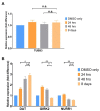Identification of DOT1L inhibitor in a screen for factors that promote dopaminergic neuron survival
- PMID: 36578445
- PMCID: PMC9791259
- DOI: 10.3389/fnagi.2022.1026468
Identification of DOT1L inhibitor in a screen for factors that promote dopaminergic neuron survival
Abstract
Parkinson's disease (PD) is a common neurodegenerative disorder characterized by the progressive loss of dopaminergic (DA) neurons in the substantia nigra region of the midbrain. Diagnostic criteria for PD require that at least two of three motor signs are observed: tremor, rigidity, and/or bradykinesia. The most common and effective treatment for PD is Levodopa (L-DOPA) which is readily converted to DA and has been the primary treatment since the 1960's. Dopamine agonists have also been developed but are less effective than L-DOPA. Although the lack of a model system to study PD has hampered efforts to identify treatments, diverse screening strategies have been proposed for identification of new pharmaceutical candidates. Here, we describe a pilot screen to identify candidate molecules from a bioactive compound library, that might increase formation, maintenance and/or survival of DA neurons in vitro. The screen used a previously characterized reporter construct consisting of the luciferase gene inserted downstream of the endogenous tyrosine hydroxylase (TH) gene and neurons differentiated from human pluripotent stem cells for 18 days. The reporter mimics expression of TH and includes a secreted luciferase whose activity can be measured non-invasively over multiple timepoints. Screening of the bioactive compound library resulted in the identification of a single molecule, SGC0946, that is an inhibitor of DOT1L (Disruptor Of Telomeric silencing 1-Like) which encodes a widely-conserved histone H3K79 methyltransferase that is able to both activate and repress gene transcription. Our results indicate that SGC0946 increased reporter luciferase activity with a single treatment for 48-h post-plating being equivalent to continuous treatment. Moreover, data suggested that the total number of neurons differentiated in the assays was comparable from experiment to experiment under different SGC0946 treatments over time. In contrast, data suggested that the survival and/or maintenance of DA neurons might be specifically enhanced by SGC0946 treatment. These results document the feasibility of a set of tools for further exploration of small molecules that may impact DA neuron differentiation, maintenance and/or survival. Results provide evidence in support of other reports that indicate inhibition of DOT1L may play an important role in maintenance and survival of neural progenitor cells (NPCs) and their lineage-specific differentiation.
Keywords: DOT1L; DOT1L inhibition; Parkinson’s disease; SGC0946; dopaminergic neuron; high throughput screen; human pluripotent stem cell; neural progenitor cells.
Copyright © 2022 Cui, Carey and Reijo Pera.
Conflict of interest statement
The authors declare that the research was conducted in the absence of any commercial or financial relationships that could be construed as a potential conflict of interest.
Figures



Similar articles
-
Dickkopf 3 Promotes the Differentiation of a Rostrolateral Midbrain Dopaminergic Neuronal Subset In Vivo and from Pluripotent Stem Cells In Vitro in the Mouse.J Neurosci. 2015 Sep 30;35(39):13385-401. doi: 10.1523/JNEUROSCI.1722-15.2015. J Neurosci. 2015. PMID: 26424886 Free PMC article.
-
The role of tyrosine hydroxylase-dopamine pathway in Parkinson's disease pathogenesis.Cell Mol Life Sci. 2022 Nov 21;79(12):599. doi: 10.1007/s00018-022-04574-x. Cell Mol Life Sci. 2022. PMID: 36409355 Free PMC article.
-
Efficient Generation of Dopaminergic Neurons from Mouse Ventral Midbrain Astrocytes.Biomol Ther (Seoul). 2023 May 1;31(3):264-275. doi: 10.4062/biomolther.2022.140. Epub 2023 Jan 16. Biomol Ther (Seoul). 2023. PMID: 36642416 Free PMC article.
-
Midbrain Dopaminergic Neuron Development at the Single Cell Level: In vivo and in Stem Cells.Front Cell Dev Biol. 2020 Jun 25;8:463. doi: 10.3389/fcell.2020.00463. eCollection 2020. Front Cell Dev Biol. 2020. PMID: 32733875 Free PMC article. Review.
-
Tyrosine Hydroxylase Inhibitors and Dopamine Receptor Agonists Combination Therapy for Parkinson's Disease.Int J Mol Sci. 2024 Apr 24;25(9):4643. doi: 10.3390/ijms25094643. Int J Mol Sci. 2024. PMID: 38731862 Free PMC article. Review.
Cited by
-
Aging and neuronal death.Aging (Albany NY). 2023 Dec 13;15(23):13579-13580. doi: 10.18632/aging.205433. Epub 2023 Dec 13. Aging (Albany NY). 2023. PMID: 38095614 Free PMC article. No abstract available.
-
Neuroenhancement by repetitive transcranial magnetic stimulation (rTMS) on DLPFC in healthy adults.Cogn Neurodyn. 2025 Dec;19(1):34. doi: 10.1007/s11571-024-10195-w. Epub 2025 Jan 24. Cogn Neurodyn. 2025. PMID: 39866659 Review.
-
Morphological profiling reveals neuroprotection via mitochondrial uncoupling in human dopaminergic neurons.Sci Rep. 2025 Aug 12;15(1):29507. doi: 10.1038/s41598-025-14735-0. Sci Rep. 2025. PMID: 40796766 Free PMC article.
-
The emerging role of DOT1L in cell proliferation and differentiation: Friend or foe.Histol Histopathol. 2024 Apr;39(4):425-435. doi: 10.14670/HH-18-658. Epub 2023 Aug 16. Histol Histopathol. 2024. PMID: 37706592 Review.
References
-
- Barbuti P., Antony P., Santos B., Massart F., Cruciani G., Dording C., et al. . (2020). Using high-content screening to generate single-cell gene-corrected patient-derived ips clones reveals excess alpha-synuclein with familial Parkinson’s disease point mutation A30P. Cells 9:2065. doi: 10.3390/cells9092065, PMID: - DOI - PMC - PubMed
Grants and funding
LinkOut - more resources
Full Text Sources

